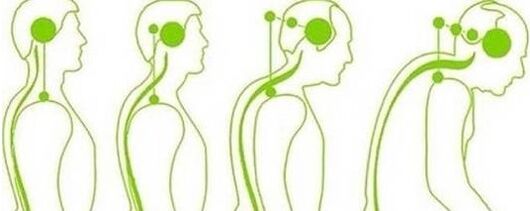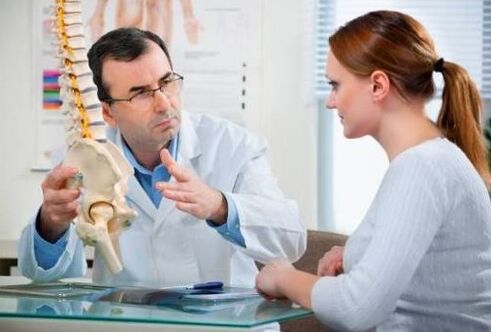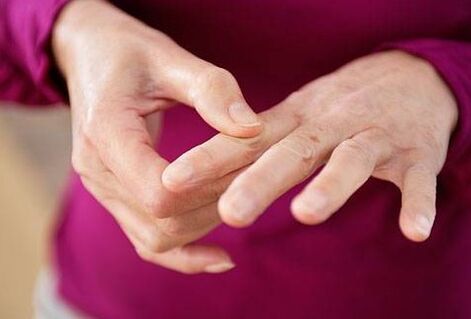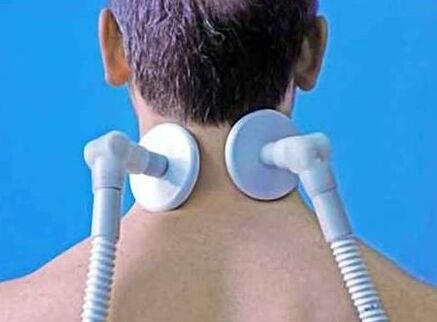Cervical osteochondrosis usually develops in adults, but due to certain circumstances, a child may happen. When any characteristic signs of such a disease appear, you should contact a therapist or a neurologist from a narrow profile.

The degenerative-distribution destruction of the spine cervical disc characterizes cervical osteochondrosis. The gradual progression of the disease leads to damage to intervertebral joints, adjacent vertebrae and ligament appliances. Many mistakenly believe that osteochondrosis is the deposition of salts. However, this statement is fundamentally wrong. Salt can actually be deposited in various joints, but with other pathologies, for example, due to the development of the gout.
Thanks to the muscular system, the dorsal spine of the human neck is performed, consisting of seven vertebrae. In this area, the muscles are poorly developed, due to which, due to long -term tension, fatigue occurs and spasms appear. In the future, the mobility of cervical vertebrae becomes limited. As a result of this condition, the discs of the spine are gradually destroyed, which causes the beginning of the first stage of osteochondrosis. In the absence of treatment, the disease is constantly progressing, causing all larger lesions of the spine. To avoid the development of complications, it is necessary to pay attention to the first signs of pathology over time and take appropriate measures.
Most of the time, people like cervical osteochondrosis are confronted with people whose lifestyle provides a minimum of physical activity and sedentary work. In such a person, the first probability, the first resources can already manifest from 25 to 30 years. Among baby and adolescence children, the disease is less common, but may also occur due to an incorrect lifestyle or heredity, other annoying factors.
Stages of pathology development and its inherent symptoms
The whole process of development of cervical spine osteochondrosis is divided into 4 main stages, each of which is accompanied by certain symptoms. Treatment completely depends on the established severity of the disease. For example, the first pre -clinical stage does not require drug treatment. To improve the patient's condition, it is recommended to radically review the lifestyle - exercise and eat right. The characteristics of this stage: excessive tension of the muscles from all over the back, the rapid appearance of a fatigue feeling, a light but tangible pain in the heads of the heads and inclinations of the head. The main disadvantage in this case can be distinguished from the fact that few people attribute due importance to these symptoms; Therefore, they do not immediately turn to the hospital.

The following symptoms are characteristic of second degree osteochondrosis:
- The pain when moving the head becomes more intense and periodically leans, hands and even the lower back;
- Pain syndrome can occur in a calm state;
- There are headaches without cause;
- Attention is dispersed, the level of work capacity is reduced.
All the above symptoms cannot remain unnoticed, so most of the time, at this stage of the disease, the patient seeks medical help. Strengthening pain is due to a decrease in distance between intervertebral discs and nerve violation. An even greater aggravation of the situation occurs in the third stage. In this case, the neck pain constantly bothers you, the muscles of the hands become very weak, from time to time, numbness occurs. As for the general symptoms, dizziness and weakness become the patient's daily companions. The cervical spine loses mobility.
Unbearable neck pain, shoulders, arms, ears in the ears, complete and impaired coordination and the appearance of obvious signs of other diseases indicates the beginning of the final fourth stage of osteochondrosis. At the same time, intervertebral discs are destroyed and the pathological process moves further along the spine, affecting other departments. It is difficult to treat this degree of disease, while at the discretion of the doctor, surgical intervention may be required. Thus, with the appearance of symptoms such as neck pain and crispness during head movements, hands, dizziness, nausea, headaches, hands and fatigue and coordination problems should become an alarming signal, indicating real health problems. Not to be a visit to the doctor, it is better to contact a therapist or immediately to a neuropathologist.
In the process of progression of cervical osteochondrosis, a violation of the spine may occur. Different sensitive and motor disorders may appear, depending on the spine, which has suffered:
- Partial or complete loss of sensitivity of the occipital region, anywhere in the neck, shoulders and arms;
- pain in any of the areas of the neck, shoulders, forearms, hands, to the tips of the fingers;
- dormancy of language, and that is why speech has damaged;
- decreased muscle tone of the head and neck;
- Problems with respiratory function, heart pain and liver.

The protruding edges of the vertebrae can squeeze arteries through which blood enters the brain. Thus, blood circulation in the brain is disturbed and the additional symptoms appear: a marked change in mood, insomnia, anxiety caused by cause, fear and irritability. At the same time, with spasm of blood vessels, not only headache, but also eye pain can happen. Patients usually observe the appearance of "flies" in the eyes, sometimes fainting are possible.
The reasons for the development of cervical osteochondrosis
The most common cause of the appearance of cervical osteochondrosis is considered a sedentary lifestyle in conjunction with inadequate and unbalanced nutrition. Often, not only lazy people suffer from their nature, but also those whose profession obliges most time to spend or the same uncomfortable pose: office staff, vehicle drivers, etc. This way of life causes a constant burden on cervical vertebrae, which is why muscle spasms arise. The appearance of degenerative processes in discs is due to a violation of metabolic processes and blood circulation. Other reasons for the development of cervical osteochondrosis include:
- Overweight caused by harmful nutrition;
- Rheumatism, scoliosis, posture problems, flat feet;
- spine and neck trauma;
- regular stress, nerve overtension;
- hereditary reason;
- Innate innate development of cervical vertebrae.
Very zealous playing sports, which means that excessively intense physical activity can also become the previous factor in cervical osteochondrosis. Primary disease under these conditions is usually a disc. The latter characterizes dystrophic disorders on intervertebral discs, mainly lumbar and cervical discords. Osteochondrosis In this case is a consequence of a disc. In addition to the exclusion of heavy physical effort, a diagnosis is required, complex treatment, medicine and physical therapy is required.

The consequences of progressive pathology
Among the complications that can occur with the development of osteochondrosis in the cervical region: it should be distinguished:
- Hernias and protrusion in the spine are formed in the third, fourth stages due to the rapid progression of the underlying disease;
- Bone tissue growth or osteophyte formation - are often precursors of protrusions. Osteophytes have an annoying effect on the nearby muscles, increasing their tone. Thus, the pressure on intervertebral discs increases. In addition, educated osteophytes can cause narrowing of the arteries;
- Spinal disc flattening - An intervertebral orifice decrease leads to a decrease in height between the intervertebral discs, the risk of a subluxation of cervical vertebrae with a marked curve of the head increases;
- Spondylolistz or displacement of the spine disk does not happen as often as other complications above, however, in case of occurrence, even death may cause death even death. Any minimum change in the most likely intervertebral disc position leads to paralysis, a more significant displacement - to death.
Cervical osteochondrosis always causes an increase in blood pressure. In addition, the transition from the underlying disease from one internship to another contributes to the progression of hypertension from the first to the third degree, in which the pressure exceeds the 180 mm mark. Treatment directly hypertension helps reduce the severity of symptoms, but only temporarily. In case of unique osteochondrosis, it is impossible to get rid of increased blood pressure. In the case of disc damage between 4 and 5 cervical vertebrae, as a complication occurs. It characterizes the pinch of nerves located in the shoulder joint connection with the hand. At the same time, intense pain occurs on the shoulder, having a negative effect on the mobility of the entire limb. In addition, manifestations of osteochondrosis cannot be based on heart disease signs, for example, angina chest, but thanks to diagnostic measures, it is possible to differentiate diseases with high accuracy.
It is impossible to determine cervical spine osteochondrosis by palpation and as a result of a visual medical examination. Based on the history collected, the doctor can only assume that osteochondrosis precisely became the cause of certain symptoms. To confirm or refute such assumption, the diagnosis is necessary. The most ideal way today is magnetic resonance imaging or magnetic resonance therapy. This method allows you to consider all bone structures, identify the presence of intervertebral hernias, the size of the osteophytes and other characteristic complications of cervical osteochondrosis. Another slightly less informative way is computed tomography. It allows to establish a diagnosis, however, the determination of hernia size, as its presence can be difficult.

Treatment of cervical osteochondrosis
The treatment of osteochondrosis of the cervical region is always complex and complex. Its duration and saturation depend on the stage of disease development, the individual characteristics of the patient and the presence of other concomitant diseases. Among the main groups of drugs, which are often prescribed in the second and more internships, should be distinguished:
- Painkillers or painkillers. Listed funds help temporarily reduce pain. With very pronounced pain, Novocaine's local block is used.
- Non -steroidal anti -inflammatory drugs and anti -inflammatory drugs steroids. Non -esteroid agents are safer, they have an analgesic effect and can become an alternative to ordinary painkillers. In the event of not relieving pain, steroid drugs are used.
- Antidepressants and sedatives - Mother Mother, Valerian Dye. Its goal is due to two factors: whether the cause of osteochondrosis is a nervous overload or if the pain is so severe that it has a negative effect on the psyche. The use of such drugs should be made under strict observation, since each of the medicines has several against -indications and is addictive.
- Muslaxantes that help relieve muscle spasms. In combination with anti -inflammatory drugs, they have an analgesic effect.
- Vasradilers that contribute to the improvement of blood circulation.
- Medicines to increase immunity and normalization of metabolic processes are ideal for vitamins B and C.
The complex of these medications is a symptomatic treatment. Compliance with all the doctor's recommendations and the approval of the prescribed course will help eliminate pain and get rid of all unpleasant manifestations of the disease. However, the therapeutic course does not end there. When the main features are eliminated, which has worsened the quality of life, you can assume the restoration of the cervical region to minimize the risk of disease relapse in the near future. Unfortunately, a big mistake of many people is that after symptoms disappear, they consider themselves completely healthy and abandoning treatment. In this situation, osteochondrosis will surely remember itself after a while.
Physiotherapy and traditional medicine
The following physiotherapeutic procedures are successfully used to treat cervical osteochondrosis:

- Medical Physical Education - It is performed exclusively under the supervision of a qualified specialist, because with severe injuries to intervertebral discs, incorrect exercises can further impair tissues;
- Manual therapy - is a manual effect in certain areas of the patient's body;
- therapeutic massage;
- reflexology and, as a variety, acupuncture;
- Electrophoresis, Balneotherapy, Laser Therapy, UFOs, etc.
Each of the above procedures has several against -indications, which is especially important for those who have an anamnesis of other diseases that are not related to cervical spine osteochondrosis. The decision on the adequacy of the use of a specific method remains with the assistant doctor. It may not be safe to perform these measures of your own free will. As for traditional medicine, you can use the grass of a saber, bran. Fig. It is also recommended to reduce salt intake. A responsible approach to the treatment of cervical osteochondrosis will make it possible to get rid of the disease for sure. Let this process take a considerable amount of time, but only complex therapy will reduce the chance to relaunch the disease to a minimum.

























